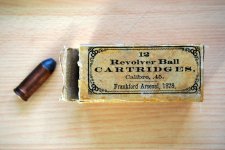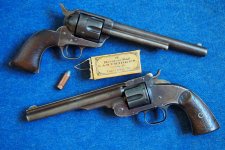I took the time to mic some 45 Schofield bores in my collection and they actually mic much smaller than the typical .454-.455 Groove diameter of the early Military Colt's 45.
The average Groove diameter of the Original U.S. Army issued Schofield .45 is .449-.450. Which simply put means they were NOT compatible.
The U.S. Army is documented in letters from the Armory to the Arsenal as "Altering" the Schofield cylinder chambers to chamber a common cartridge for both the Colt's SAA and the Smith & Wesson Schofield Revolver.
The only way to accomplish this was to grossly oversize the chambers of the Schofields to chamber the same cartridge diameter as the Colt's "AND" manufacture a hollow base inside lubricated bullet to function in both revolvers.
This authentic dug up hollow base bullet seen in the below photo's is "NOT" a Schofield round as I originally thought. It is the "dual purpose" round for both guns. That was actually and documented as being introduced in 1875 with an order to manufacture 1 million of these custom .45 caliber cartridges.
It's amazing really that when sent to Surplus in early 1880 the guns were already Armory altered. So, commercially sold Schofields that never went to the U.S. Army would not have the same chamber diameter as the Altered U.S. Schofields. Therefore, many of the Surplus Arsenal rounds must have been sold to surplus as well so the guns could be serviceable. Those would include the Wells Fargo and American Express examples. This would also be a solid method to prove without question that you have either a Civilian sold gun or a U.S. Army "Altered" Schofield.
It's also possible that the Civilian sold Schofields were later altered by the owner simply because the original rounds would be very difficult to find. That's also likely why they are literally impossible to find today.
What a mess that must have been for Commercially sold owners of original Schofields. Having smaller chambers, the military rounds would not fit or function in them and the opposite would also be true. Original Schofield rounds would not fit or function in the U.S. Altered Schofield revolvers...The chambers being grossly oversized.
Murph
The average Groove diameter of the Original U.S. Army issued Schofield .45 is .449-.450. Which simply put means they were NOT compatible.
The U.S. Army is documented in letters from the Armory to the Arsenal as "Altering" the Schofield cylinder chambers to chamber a common cartridge for both the Colt's SAA and the Smith & Wesson Schofield Revolver.
The only way to accomplish this was to grossly oversize the chambers of the Schofields to chamber the same cartridge diameter as the Colt's "AND" manufacture a hollow base inside lubricated bullet to function in both revolvers.
This authentic dug up hollow base bullet seen in the below photo's is "NOT" a Schofield round as I originally thought. It is the "dual purpose" round for both guns. That was actually and documented as being introduced in 1875 with an order to manufacture 1 million of these custom .45 caliber cartridges.
It's amazing really that when sent to Surplus in early 1880 the guns were already Armory altered. So, commercially sold Schofields that never went to the U.S. Army would not have the same chamber diameter as the Altered U.S. Schofields. Therefore, many of the Surplus Arsenal rounds must have been sold to surplus as well so the guns could be serviceable. Those would include the Wells Fargo and American Express examples. This would also be a solid method to prove without question that you have either a Civilian sold gun or a U.S. Army "Altered" Schofield.
It's also possible that the Civilian sold Schofields were later altered by the owner simply because the original rounds would be very difficult to find. That's also likely why they are literally impossible to find today.
What a mess that must have been for Commercially sold owners of original Schofields. Having smaller chambers, the military rounds would not fit or function in them and the opposite would also be true. Original Schofield rounds would not fit or function in the U.S. Altered Schofield revolvers...The chambers being grossly oversized.
Murph
Attachments
Last edited:





